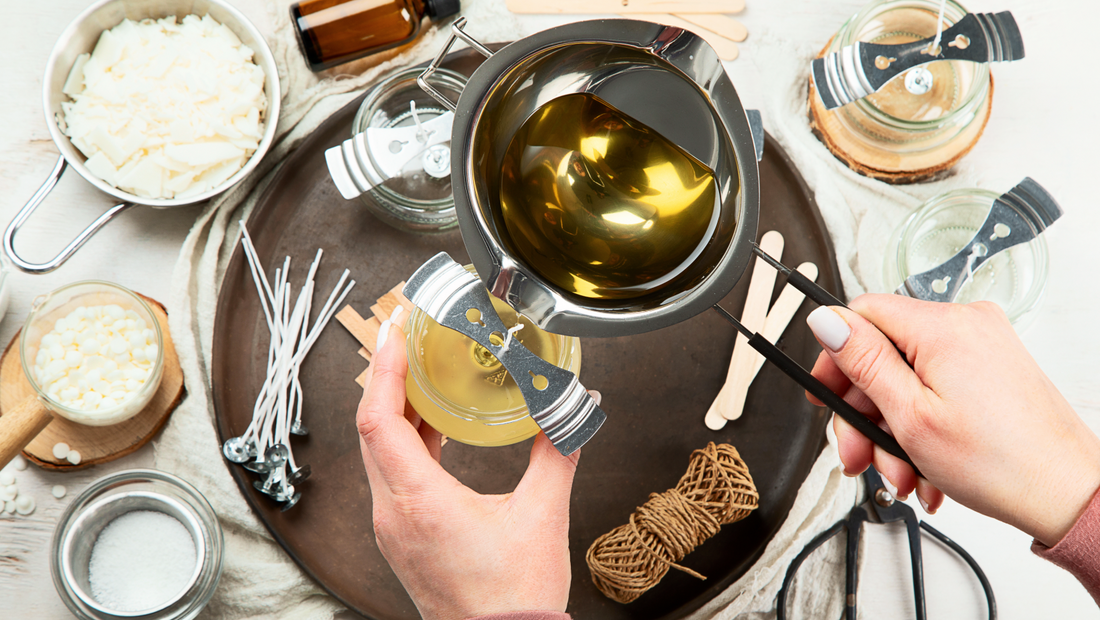With the huge variety of candle supplies available, you might be wondering where to even begin. That’s why we wanted to make this easy list of materials to get you started. If you have no supplies at all, the section on Necessary Supplies includes the basics. If you already have some equipment or want to branch out, the Optional Supplies section has several other tools you might like using.
Where to Find Candle Supplies
Making candles requires a few special tools. You might already have some of these supplies at home. However, you will need to buy certain tools and ingredients before starting.
Before diving into your kitchen drawers, keep in mind that you shouldn't use any candle making tool for food prep in the future. For example, you don't want to use your favorite spatula or whisk to make candles. Keep a dedicated tool just for candles and crafts, and don't use it for cooking again.
With that said, some kitchen tools are okay to use. For example, you can use a kitchen scale to weigh your wax and fragrance as long as you keep the scale covered.
NorthWood carries all the supplies mentioned in this blog. Check out our full collection of tools & supplies to find everything you need. Fortunately, a lot of these tools are reusable, and you can use them each time you make candles! Plus, investing in high-quality tools will help you keep your candle prices low if you're selling your creations.
Necessary Candle Making Supplies List
Some tools are optional, but others are not. At a minimum, you will need these basic supplies to make a candle:
- Containers
- Wax
- Wicks
- Fragrance
- Measuring cup
- Melting pot
- Stirring tool
- Thermometer
- Wick stabilizers
- Glue dots
Learn everything you need to know about these tools below.
Containers
Unless you’re using pillar wax, 100% paraffin wax, or 100% beeswax, you will need to use containers to make candles. This is because most candle wax is too soft to use in a candle mold. The jar simply keeps the wax contained when you light the candle.
Candle jars are usually glass, tin, or ceramic. As long as your candle is properly wicked (i.e. you’re not using a wick that burns too hot), plastic candle votives are suitable too. Just make sure they are votives designed for candlemaking.
Although lots of containers work for making candles, we recommend buying jars made just for candles. Many people like reusing old jars or making candles in antique vessels. However, this can be dangerous if the material is not heat resistant.
Wax
What wax do you need to make candles? Waxes such as EC-26, Ceda Serica, and CB2 are all good for making container candles. These are all coconut wax blends designed for container candles. On the other hand, Soy flakes are a great option if you prefer soy wax.
Paraffin and beeswax are also good choices for candles. Keep in mind beeswax can be more challenging to wick because of how hard the wax is. Harder waxes have a higher melting point and typically need a larger wick compared to coconut and soy blends.
Not sure where to get wax? We carry a full range of candle wax to choose from.
Wicks
After deciding on a wax and container, you will need to choose a wick. Choosing your wick is often the hardest part. Dozens of wick types are available, but wicks also come in tons of different sizes.
However, we have lots of resources that make it easier to choose a wick. Our Wick Size Chart helps you choose the right size, and our wick type blog covers the different varieties available.
Fragrance
You can make an unscented candle, but chances are, you probably want your candle to have a scent. All our fragrances are suitable for making candles! You might also be wondering if you can make candles with essential oils, but this is something we don’t recommend.
While fragrance oils are formulated to smell strong in candles, essential oils are not. Essential oils smell great in a diffuser, but it's challenging to get the same scent when burned in a candle. You can certainly make candles with essential oils. However, you will get a much stronger scented candles using fragrance oils.
Melting Pot
A metal pouring pitcher is necessary for melting your wax. This tool can be put into a pot of water to create a double boiler that you heat on the stove top. Some candle makers will also place their metal pouring pitchers directly onto a burner or hot plate. However, we recommend using the double-boiler method to keep your melting pot looking its best.
You can also find melting pots designed just for making candles. However, these are more of an investment. When you're just starting, heating your wax on a stove is a great option.
Stirring Tool
A stirring tool works great for helping your wax melt and for mixing in your fragrance oil. You can use any heat safe tool for stirring. A mini nylon whisk is great if you’re melting a small amount of wax. Any silicone spatula will also work well.
Thermometer
Temperature is important when making candles. This is because you need to get your wax to a certain temperature before adding fragrance. For soy wax, this is 185 degrees F. Coconut wax, on the other hand, needs to be over 200 degrees F before adding fragrance.
If you don't get your wax hot enough, the fragrance won't bond properly with the wax. At the same time, over heating your wax can cause it to undergo chemical changes. Head to our fragrance temperature blog to learn more.
A digital thermometer, probe thermometer or dial thermometer all work well to check the temp of your wax. Each type of thermometer has its benefits, so choose whichever design you like best.
Wick Stabilizers
Many candle making tutorials will tell you to use a popsicle stick or other similar tool to hold your wick in place. However, this method can be ineffective, which is frustrating when you’re a beginner.
We recommend using either a wick stabilizing bar or a bow tie wick bar to hold your wick in place. These metal tools are completely reusable, and have notches that keep your wick straight and centered.
Glue Dots
Glue dots are super-sticky dots that attach your wick to the bottom of the container. They keep your wick from floating away or bending when you pour the wax, which is important for keeping the wick straight and centered.
Measuring Cup
Measuring beakers have lines that help you add a precise amount of fragrance. Beakers are handy for because they have a pouring spout. This makes it easy to transfer the fragrance to your melted wax.
If you're making a large batch of candles, we always recommend weighing your fragrance on a scale rather than measuring by volume. This is because fragrances oils can have different densities, which can lead to inaccurate measurements.
This difference might be negligible if you’re making a single candle. However, it’s good to get in the habit of weighing your fragrance oils, as this is far more accurate for large batches.
Optional Supplies
To take your candlemaking up a notch, pick up these optional supplies.
Cutting Tool
If you’re working with a slab of wax, you will want a cutting tool to slice the wax into smaller pieces. This makes it easier to weigh the wax, and smaller pieces will also melt faster. You’ll also want a cutting board when cutting wax.
Scale
When making candles, it’s highly recommended that you measure ingredients by weight rather than volume. You may also want to have a plate or bowl to put your wax in when weighing it. This keeps your scale clean.
Nitrile gloves
It helps to wear gloves while making candles, as handling wax and fragrance oils can be messy. While many fragrance oils are skin-safe, you don't necessarily want fragrance oil getting directly on your hands.
Colorants & Wax Additives
Additives like stearic acid are optional. Stearic acid makes candle wax harder and also helps the wax adhere to the walls of your container. We recommend making your first batch of candles without additives so that you can form a baseline of how your candles perform without them.
To make colorful candles, pick up some candle dye chips or liquid dye. We don’t recommend mica, glitter or other powdered colorants for making candles. Crayons are also not ideal for coloring candles.
Heat Gun
A heat gun can be a helpful tool when making candles. You can use a heat gun to pre-warm your container before pouring the wax. They’re also handy for re-melting the top of your candle to smooth the surface or melt drips of wax inside the container.
Labels
If you are selling or gifting your candles, make sure you pick up some candle warning labels. These labels include instructions for burning a candle safely. They’re a must-have if you are giving your candles to anyone else to use.
Trimming Scissors
Most candle wicks are 6” in length, which is longer than you need for most containers. Before you burn your candle, you will need to trim the wick to a safe length (approx. 1/4”). Our wick trimmers are great for doing this.
You might also like using a bell snuffer to extinguish your candle after testing it. Bell snuffers allow you to put out a flame without blowing wax out of the melt pool. They’re available in four colors to match our wick trimmers.
Ready to start making candles? Check out our blog on making your first candle for a detailed explanation of whole candle making process.

